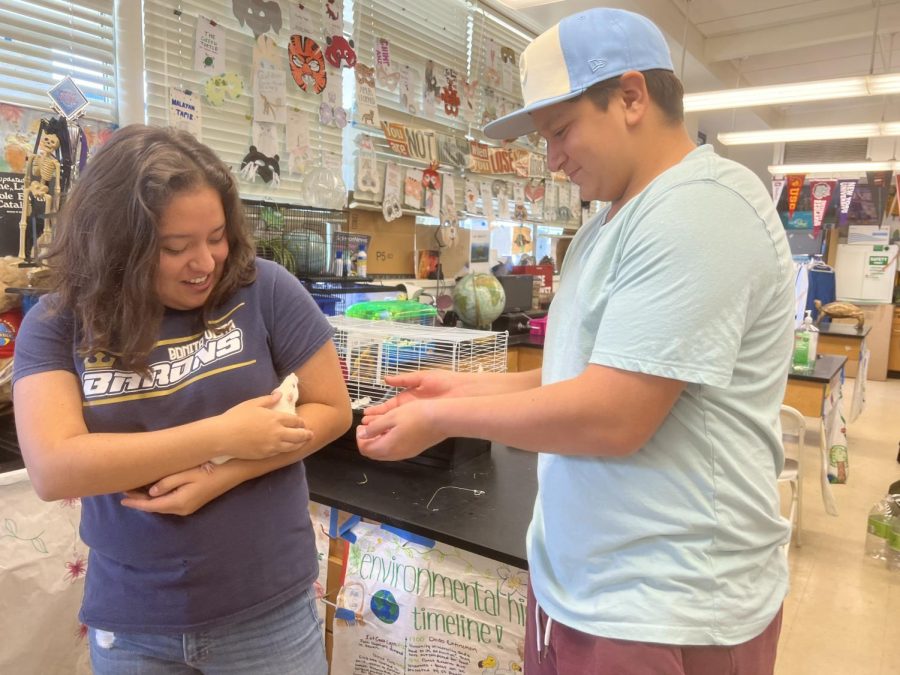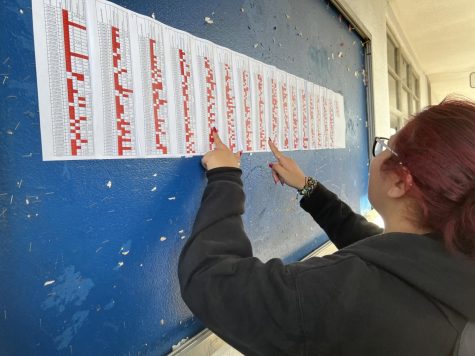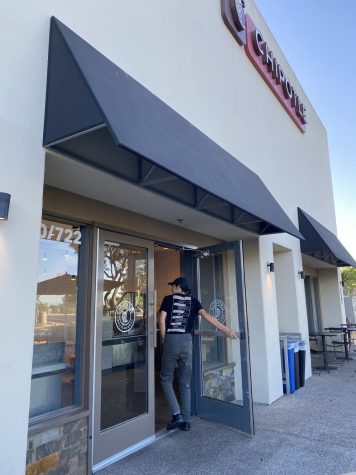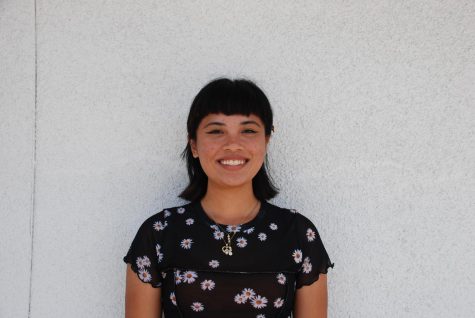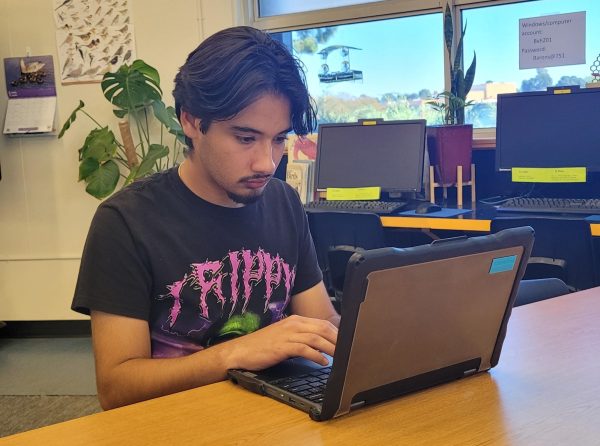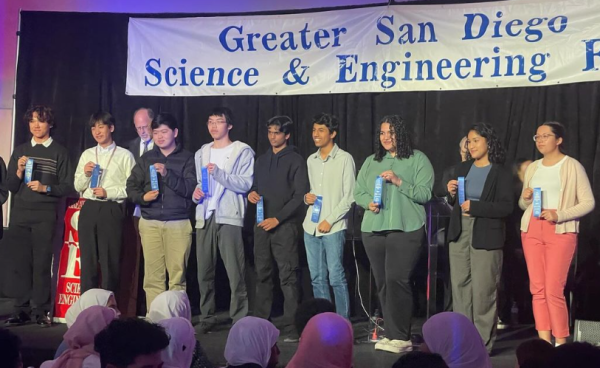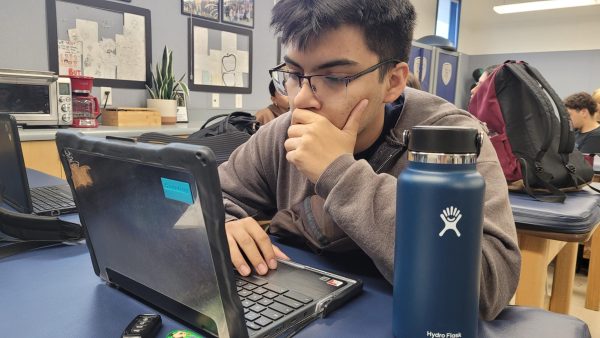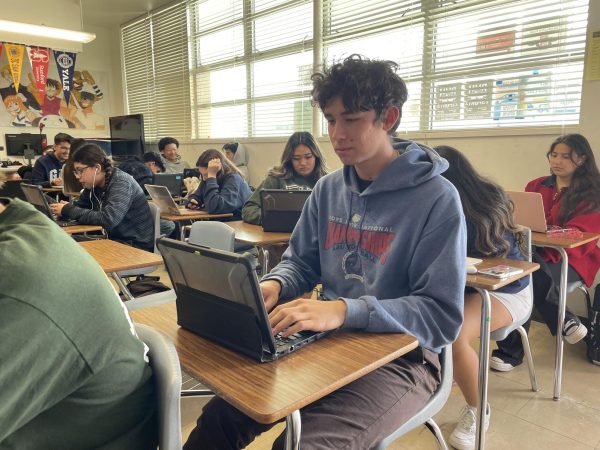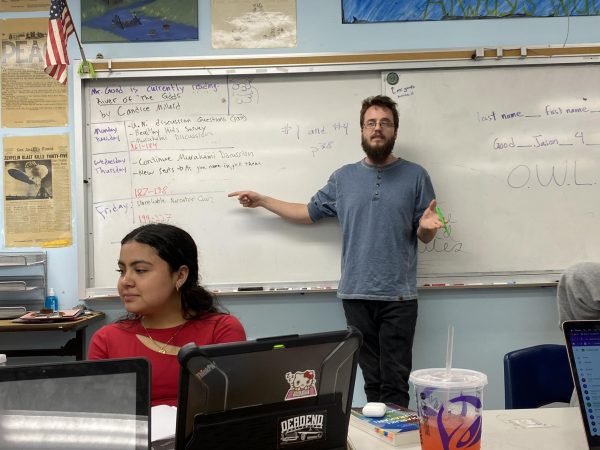A new addition
Room 402 welcomes two new rats to class after a student rescues them
International Baccalaureate Environmental Systems and Societies (IB ESS) students and juniors Erika Palacios (left) and Nicholas Sanchez (right) take the rats out of their cage during their in-class break. During the short breaks in her class, Accelerated Biology and IB ESS teacher Jennifer Ekstein allows her students to play with the class pets.
November 17, 2022
In room 402 at Bonita Vista High (BVH), a number of creatures can be found living comfortably, including two rats that made that classroom their new home. Accelerated Biology and IB Environmental Systems and Societies teacher Jennifer Ekstein, introduced two rats to her students, Kaito and Gloria Groove. Both rats were rescued by freshman Dahlia Grottick in October from her father’s animal testing laboratory and were brought to Eksteins classroom.
“These rats have a story. I think students who are normally afraid of rats or rodents can make a connection if they understand a little bit of the backstory. ‘Oh, I can’t believe they were used for animal experimentation, I’m so glad we rescued them.’ Then it builds a little bit of emotion and humanity into why I have them,” Ekstein said.
Grottick felt Ekstein’s classroom would be a good home for the rats because she describes it as being a very inclusive environment. Ekstein and Grottick are deeply connected simply because they both have an undeniable love for rats.
“[Ekstein’s] classroom is very inclusive and she loves rats too. I know that hamsters and rats don’t have the longest lifespan, so I know that if they are there until they die, it would be a good place for them,” Grottick said.
Not only has Ekstein kept rats in her classroom, she also shelters several other animals. She is always up for a challenge when it comes to who she invites into her class. She believes that it is important to keep animals on campus. For some people, animals are their children. They hold a very special and important place in their life. There’s a connection students build with these animals and I think that’s very important. — Accelerated Biology and IB Environmental Systems and Societies teacher Jennifer Ekstein
“I’m a biology teacher. I should have all these living things in my class to inspire students and have them want to come and experience a very positive, warm and caring atmosphere,” Ekstein said. “It’s nice to have somewhat of a zoo in there that can reference these animals. So, it just creates a warm environment.”
Before entering the class, Ekstein explains how students at first are often afraid of rats. They are seen as disgusting rodents, but junior and Vice President of Sloth Club—a club dedicated to saving endangered animal species—Emily Zepeda believes otherwise. She explains how rats are often looked down on, but she still enjoys their presence on campus.
“I feel like with rats, [students] don’t care very much because they’re often seen as disgusting,” Zepeda said. “I feel like [students] pass them along as if they’re just objects, but it’s definitely respectful enough to where there will be no harm [towards the rats] at all.”
Before the rats were introduced to BVH, Ekstein and Grottick explain how they would’ve been subjects of animal testing. She prioritizes animal safety, finding herself staying away from products that test on animals in her everyday life. She makes the best effort to ensure that animals are living under proper conditions.
“Any type of product that I buy, I usually look for the little rabbit symbol on it. Itshows that there was no animal testing on that product. That’s kind of my mantra, I try to buy products that do not have any animal experimentation involved,” Ekstein said.
Zepeda adds how she and her peers have had positive experiences with the new rats so far. She explains how the rats have made class time more enjoyable and how excited she is to have the new pets in the classroom.
“It makes [class] more fun because whenever we have free time, it’s what [most students] go straight to. They usually get the hamsters and now we also have the option of getting the rats to play and hold them,” Zepeda said.
While Grottick believes that rats are similar to common pets like cats and dogs, she also emphasizes that people need to be well informed about rats like Kaito and Gloria Groove. She explains that without Ekstein, the rats would not be here today.
“I’m really grateful for our biology teachers here in the classroom because they love and care about the rats just like I do,” Grottick said.
As time goes on, the rats continue to be showered with love and affection by many. Students are beginning to gradually get more comfortable with them as they are a notable part of the class. Students and staff cherish each moment they spend with these new additions to Ekstein’s animal family, cultivating a new found love for these furry friends.
“For some people, animals are their children. They hold a very special and important place in their life. There’s a connection students build with these animals and I think that’s very important,” Ekstein said. “It motivates students to come to school when they have something to connect with.”

